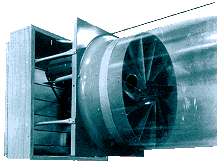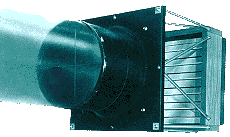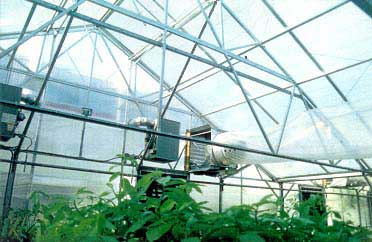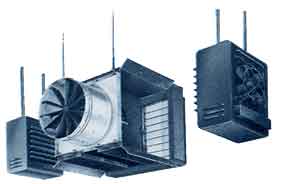Ideal for Air Circulation, Ventilation, Heat Distribution and Dehumidification.
Integrates with all other Environmental Control Systems.


The Acme Fan-Jet system integrates the movement of air for internal air circulation coupled with inducing fresh air into the building, removal of air through exhaust fans. It also dramatically increases air movement within the building. Beneficial to growing crops, poultry, hog and animal health and providing much needed air circulation among product storage.
Fan-Jet (or fanjet) can be used for greenhouse, agriculture, poultry, hog, ventilation or general cooling. It also works well in a fan and pad cooling system. It serves as a dehumidification system as well.
Fanjet systems design information can be found in the fanjet section of the Acme Climate Control Handbook
Overhead Heating System
Greenhouse is a difficult structure to heat and contains plants that are extremely sensitive to temperature variation. Greenhouse heating process is unstable since the warmed air being lighter rises to the roof. Cold air produced near the glass or plastic covering is heavier and settle to the floor. When still air is in the house, a cold spot with extreme humidity’s may develop.
Overhead air motion and mixing will help prevent this settling action from the roof. Cold air is best handled by release of heat from perimeter heating system to intercept cold air pouring down walls before it gets to floor. Works in areas where snow melting is required in gutter connected houses, provision should be made to supply gutter heat.
Why use Fan-jet for Air Circulation
Temperature of plants in greenhouse is primarily determined by inside air temperature. Main function of heating system is to maintain uniform air temperature in the house. The Fan-Jet overhead and perimeter working directly with air in greenhouse make ideal method of heating air and achieving uniformity.
Description of a Fan-Jet Heating System
Use of a Heat Kit
The Fan-jet unit with a heating accessory “heat kit” is designed to receive heated air from conventional type unit heaters. It distribute heated air uniformly throughout the house. Heating accessory consists of a baffle arrangement that closes the top and bottom space between the pressurizing fan and the inlet shutter. Sides remain open to admit the heated air blown from conventional horizontal discharge type unit heaters spaced a fixed distance away from the side inlets.
How Fan Jet Works in the greenhouse and building
When equipment control calls for heat and turns on unit heaters, they blow heated air into open sides of Fan-jet. Heated air propelled down the tube and distributed uniformly within the house. When desired temperature is reached, unit heaters are automatically turned off . Fan-jet continues running and recirculating air within the house.
Since the heaters are not built into the main air flow path of the Fan-jet system, they never restrict flow of air. Whether system is supplying fresh air, heating, or recirculating air within the greenhouse. This results in much higher efficiency than other systems providing much more air flow for all its uses. This process results lower horsepower and operating costs.
When the Fan-Jet is used for ventilation, motorized shutter opens, Fan-Jet pulls air into the building. Then distributes it down the house through poly tubes designed for maximum air movement within the house. When motorized shutter opens, exhaust fan comes on and balanced same CFM’s as Fan-Jet. It then exhaust old air from building and Fan-jet brings in fresh outside air.
The Fan-Jet used as dehumidification.
When excess humidity is built up within the house, through evaporation of crop, watering plants in greenhouses. Humidity is added to the air, fresh outside air with lower humidity is introduced into the greenhouse. Then old air is exhausted out of the house by exhaust fan and some dehumidification occurs.
When outside humidity is high and reduction of humidity is required, air entering the house through Fan-Jet is heated with a heater, mounted alongside the Fan-Jet. When air is heated 20 degrees, humidity drops 50%. Higher temperature air has a lower humidity. The Fan-Jet system spreads this lower humidity air throughout the house.
Fan-Jet for air circulation within a greenhouse.
This is a benefit to greenhouse crops, hog, poultry and animals, product storage and people. For air circulation when a motorized louver is closed, the Fan-Jet fan distributes internal air through the house evenly and that air is then properly circulated, drawn back up through the Fan-Jet in a continuous airflow pattern that gives even flow of air within the house.
Beneficial in heat savings, as warm air rises and as the Fan-Jet is normally in the higher parts of the house. The circulation system forces the warm air down, down onto crops, people and product, thereby reducing heating costs.
 Heat Kits for overhead heating
Heat Kits for overhead heating
CAUTION! To avoid combustion malfunctions when two heaters are used with one Fan-Jet; minimum heater distance from Fan-Jet opening must be maintained. Both heaters must operate simultaneously unless center baffle is used, and the discharge louvers must be directed toward the top of the Fan-Jet opening.
Acme Heat Kits allow use of gas fired, electric, steam or hot water unit heaters without outside air passing through the heat exchanger. When used with Fan-Jet, Heat Kits keep coils and elements out of the air flow route, thus saving energy.
Easy to Install
Kits also come with a Fan-Jet motor shield to prevent heat build-up. A center baffle accessory is included for use when opposing heaters trigger separately, preventing blow-through of hot air and possible motor damage.
“The unit heater louvers should be at the same elevation as the Fan-Jet inlet opening and spaced a proper distance from it. Axis of unit heater discharge opening directed toward the Fan-Jet inlet opening. If heater is positioned below the level of Fan-Jet inlet opening to maintain the proper spacing, louvers should be adjusted. Direct heated air upward toward top of inlet opening.
The Need for Well-Distributed Heat
If Fan-Jet end of building is colder than remainder of the house, correct by adjusting one or two of lower louvers of heaters to downward position to divert part of heated air to end wall area.
CAUTION! Guards are strongly recommended when the fan is installed within seven (7) feet of the floor, working level or within reach of personnel. Guards complying with OSHA regulations are available as optional equipment. Review OSHA Codes and obtain a quotation.
The unique Fan-Jet is a special tube pressurizing fan with curved stationary discharge vanes (stator vanes) that recover the rotational energy of discharging air to increase performance capacity and efficiency.
Fan-Jet Characteristics
LOW COST: Fan-Jet powers more air at less horsepower for best results at low operating costs.
QUALITY: Fan-Jet is fully assembled at factory, test run and inspected and then shipped ready to install with brackets and fasteners.
DIRECT DRIVE MODELS – RC 18 – Direct drive models are capable of variable speed control.
BELT DRIVE MODELS – RC 24, 30 – Belt drive models features no-service sealed fan shaft ball bearings captured in a unique casting to maintain proper alignment and spacing.
BUILT TOUGH: The steel model RC is available in 18″, 24″ and 30″ sizes and is rust protected with a metal wash process and a two-coat, baked-on finish.
HIGH PERFORMANCE PROPELLERS: The propellers are matched to the size, performance and construction of the Fan-Jet. RC fan propellers are welded steel with a two coat finish.
ENERGY EFFICIENT: All motors are totally enclosed, high efficiency design with shielded ball bearings and include thermal overload protection on single phase models.
Models RC are listed by Canadian Standards ; Association Testing Laboratory as approved.
FAN-JET PERFORMANCE DATA |
||||||||||
|---|---|---|---|---|---|---|---|---|---|---|
| ‡Heating Capacity with Heat Kit BTU/Hr, Output Heater Temperature Rise of | ||||||||||
| Fan-Jet Model | HP | RPM | Tube Size |
System CFM |
Motorized Shutter Model |
Heat Accessory |
40º | 50º | 60º | 70º |
| †RC12D4 | 1/8 | 1725 | 12″ | 1180/780 | WAAC1818 | NA | NA | |||
| RC18E6 | 1/4 | 1160 | 18″ | 3120 | WAAC2626 | HT18 | 112,000 | 138,000 | 163,000 | 186,000 |
| RC/RCA24F | 1/3 | 735 | 24″ | 5420 | WAAC3333 | HT24 | 172,000 | 212,000 | 250,000 | 287,000 |
| RC/RCA24F2S | 1/3 | 735/490 | 24″ | 5420/2710 | WAAC3333 | HT24 | 172,000 | 212,000 | 250,000 | 287,000 |
| RC/RCA30G | 1/2 | 607 | 30″ | 8550 | WAAC4040 | HT30 | 278,000 | 342,000 | 403,000 | 463,000 |
| RC/RCA30J | 1 | 757 | 30″ | 10600 | WAAC4040 | HT30 | 345,000 | 424,000 | 500,000 | 574,000 |
Order Cam Motorizing kits for shutters separately.
‡ The Order rating for gas fired heaters is 80% of their input BTU ratings.
PLEASE ADVISE VOLTAGE REQUIREMENTS WHEN INQUIRING.



 Heat Kits
Heat Kits